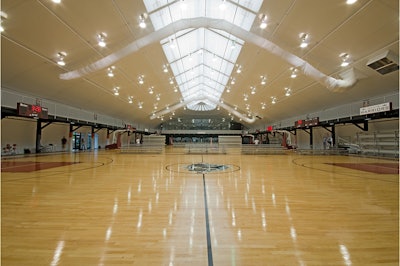
Sprung Structures — a fifth-generation, family-owned business with a history dating back to 1887 — innovated tensioned membrane modular buildings for many sectors, including aviation and aerospace, education, power and energy, municipal and military. But the global company’s fastest-growing market is the sports and recreation industry.
“The cost and timelines associated with conventional concrete, tilt-up and steel buildings are excessive, and that’s where we come in,” says Jim Avery, Sprung’s vice president, noting that Sprung Structures are particularly popular for housing gymnasiums, swimming pools, ice rinks and pickleball courts.
Sprung facilities offer design flexibility, energy efficiency that contributes to LEED certification, durability and lower overall project costs. A building can be constructed for about one-third less than conventional construction, according to Avery. Construction time typically is in the four- to eight-month range.
But to the uninitiated, Sprung Structures might be considered “tents” — a common misperception that company officials counter by explaining that Sprung buildings are engineered for permanence and designed for multi-use applications.
The buildings feature a corrosion-free, high-performance aluminum substructure that outperforms steel, a performance daylight membrane designed to provide maximum longevity and colorfastness, premium insulation that offers all-weather durability and cost-saving energy efficiency, and a wide range of stylish and functional accessories such as doors, windows, canopies, covered walkways, glazing walls, translucent panels, graphics and more. Sprung Structures also come in an array of colors, and optional daylight panels across the peak increase ambient lighting. No drywall, studs or interior support pillars are required (which saves on interior expenses), and the company’s technology-backed approach avoids supply-chain challenges and traditional construction delays.
Clearly, a Sprung Structure is no tent.
“Air-supported structures were the first generation of fabric-built buildings on the market,” Avery says. “They’re inflated, they require a tremendous amount of energy to keep inflated and they’re not very reliable — particularly in winter. We’re considered a frame-supported structure, as opposed to an air-inflated structure, and it’s looked at differently in building codes.”
Sprung buildings meet several international building standards that confirm their strength and durability; they also meet the strict Miami-Dade County (Fla.) Hurricane Compliance Code. After Hurricane Katrina struck in 2005, the only building left standing in Buras, La., was a Sprung tension-fabric structure.
“The Sprung Structure is the absolute future of construction,” says Kurt Lundell, a California-based regional business development manager for the company. “This is where the bulk of opportunities in the construction industry are going to go, and we’re leading the way with our building technology.”
Recent installations of Sprung Structures include The Crew Center in Woodbine, Iowa (formerly the Woodbine Community Wellness Center); the Martensville Athletic Pavilion in Saskatchewan, Canada; Edwards Air Force Base in California; aerospace company Blue Origin’s headquarters in Kent, Wash.; and the Berce Athletic Center at Regis University in Denver.
“The key is the natural light — the openness and the height of the facility. Volleyball players coming in love that,” Mike Redmond, associate vice president of physical plant and capital projects at Regis University, said in a video about the facility, adding that the 130-by-150-foot structure’s affordable price tag and four-month construction timeline appealed to university officials. “There are a lot of structures that have limitations. This structure, with the way it’s built, can be adjusted and set up in a certain way that it will work for athletics very well. It [also] really expanded our events side to where we can do multipurpose events. We’ve never had a facility this large to be able to do that.”
Other facility operators tell similar stories.
“The building is as beautiful as the day it opened,” David Lunn, director of facilities for Christ the Redeemer Catholic Schools, which oversees the gymnasium at École Good Shepherd School in Okotoks, Alberta, Canada, said four years after the Sprung facility was built. “The students, staff and community user groups have a beautiful, bright and extremely functional gymnasium [of] which we are all very proud.”
Architects recognize the advantages of designing with Sprung, too. “The column-free span of the Sprung Structures opened up design flexibility,” said one architect.
“The Sprung system provides opportunities for natural light panels without any penetrations through the membrane,” added another.
Today, there are more than 12,000 Sprung Structures erected in more than 100 countries by facility operators who recognize the company as offering the fastest way to build high-performance fabric structures.
“The sports and recreation segment is poised for huge growth,” Avery says. “By using a Sprung Structure, you can simplify the process, you can complete construction much quicker, and you don’t have to sacrifice anything. That’s the key.”












